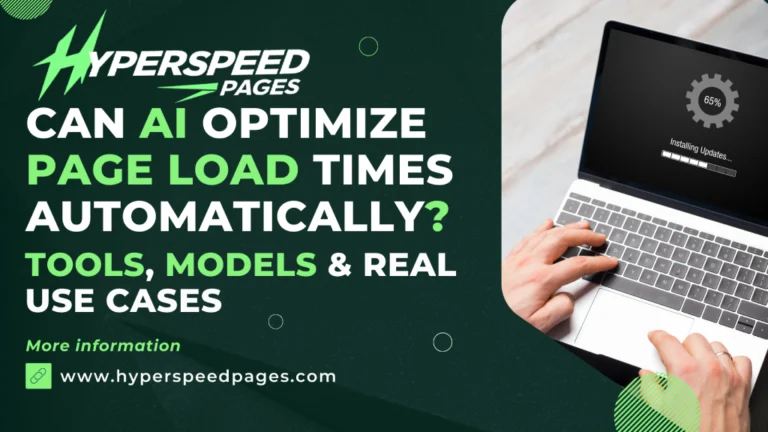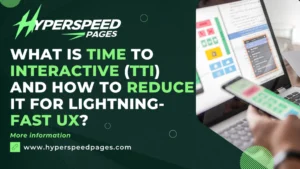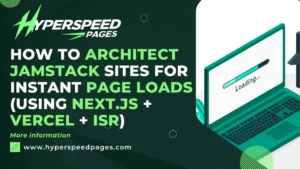
Blending Artificial Intelligence (AI) into web performance optimization is revolutionizing how developers enhance page load times. Google ranks pages loading under 0.5 seconds higher, and 53% of users abandon sites that take over 3 seconds to load. Traditional optimization methods (manual caching, CDN tweaks) are no longer enough, AI is now automating speed enhancements with unprecedented precision.
What is AI-driven Page Load Optimization?
AI-driven page load optimization refers to the use of machine learning algorithms and predictive analytics to automatically enhance website performance. This involves analyzing user behavior, network conditions, and device capabilities to make real-time adjustments that improve load times.
Key AI Techniques Enhancing Page Load Speeds
1. Predictive Resource Loading
How does predictive resource loading work?
AI models analyze user navigation patterns to anticipate which resources (e.g., images, scripts) a user is likely to request next. By preloading these resources, websites can reduce perceived latency and improve user experience.
Example: An AI system detects that users often navigate from the homepage to the product page. It preloads product images and scripts while the user is still on the homepage, ensuring faster access when they transition.
2. Dynamic Image and Asset Compression
What is dynamic image and asset compression?
AI algorithms adjust the compression levels of images and other assets in real-time based on the user’s device, screen resolution, and network speed, balancing quality and performance.
Example: A user on a slow mobile network receives highly compressed images, while a user on a high-speed connection gets higher-quality visuals, optimizing load times for both.
3. Smart Code Splitting
How does smart code splitting improve performance?
AI analyzes user interaction patterns to determine which parts of the JavaScript code are necessary for initial load and which can be deferred. This reduces the initial payload and speeds up page rendering.
Example: Non-essential scripts, like those for chat widgets, are loaded after the main content, ensuring quicker access to primary features.
4. Server Load Balancing and Response Prediction
What role does AI play in server load balancing?
AI monitors traffic in real-time to distribute requests evenly across servers, preventing overloads and ensuring consistent response times.
Example: During a flash sale, AI detects a surge in traffic and dynamically allocates resources to maintain optimal performance.
AI Tools and Models for Web Performance Optimization
1. Coframe
What is Coframe?
Coframe is an AI-driven platform that continuously tests and refines website elements, such as text, visuals, and code, to personalize user experiences and enhance performance.
Real-World Impact: Trials with a major international company showed a 42% improvement in click-through rates and a 352% increase for a particular customer segment.
2. PixLift
How does PixLift optimize web browsing?
PixLift reduces webpage sizes by downscaling images during transmission and uses AI models on user devices to upscale them, trading computational resources for bandwidth.
Benefit: Enables more affordable and inclusive web access, particularly in regions with limited connectivity.
3. nnJIT
What is nnJIT?
nnJIT is an in-browser inference system that uses just-in-time kernel optimizations to enhance deep learning performance on edge devices, reducing latency and improving user experience.
Advantage: Achieves up to 8.2x faster performance compared to existing baselines.
Top AI Tools for Automatic Page Speed Optimization
Automated CDN Optimization (AI-Powered Edge Networks)
1. Cloudflare AI
Dynamically adjusts cache rules based on traffic patterns.
Case Study: Reduced Walmart’s LCP by 22% via smart TTL adjustments.
2. AWS Lambda@Edge with SageMaker
Uses ML to route users to the fastest edge node.
AI-Based Image & Asset Optimization
1. Kraken.io AI
Converts images to AVIF/WebP based on device/browser.
2. ImageFlow
AI removes invisible pixels (saves 15% image weight).
JavaScript & CSS Optimization
1. DeepCode AI
Identifies unused JS/CSS with 98% accuracy.
2. Google’s Closure Compiler (ML Mode)
Rewrites inefficient code.
Core Web Vitals Auto-Fix Tools
1. SpeedVitals AI
Diagnoses INP/LCP issues and suggests fixes.
2. Lighthouse CI + GPT-5
Automatically generates optimization pull requests.
Real-World Applications of AI in Page Load Optimization
Case Study: E-commerce Platform Enhancement
An e-commerce platform integrated AI-driven predictive loading and dynamic asset compression. The result was a 30% reduction in page load times and a 15% increase in conversion rates.
Case Study: News Website Performance Boost
A news website employed smart code splitting and server load balancing powered by AI. This led to a 25% improvement in load times during peak traffic hours.
Limitations: Can AI Replace Manual Optimization?
Where AI Excels
- Real-time adjustments (traffic spikes, CDN routing).
- Predictive optimizations (preloading, smart caching).
Where Humans Still Dominate
- Complex architectural decisions (migrations to edge SSR).
- Custom business logic (e.g., checkout flow tweaks).
AI has become an indispensable tool in optimizing page load times, offering dynamic solutions that adapt to user behavior and system conditions.
Frequently Asked Questions
1. Can AI automatically improve my website’s load times?
AI can analyze various factors such as user behavior, device type, and network speed to make real-time adjustments that enhance load times.
2. What tools can I use for AI-driven optimization?
Tools like Coframe, PixLift, and nnJIT offer AI-powered solutions for optimizing different aspects of website performance.
3. How does AI contribute to Answer Engine Optimization (AEO)?
AI helps structure and present content in a way that’s easily interpretable by AI-driven search engines, improving visibility and accessibility.




